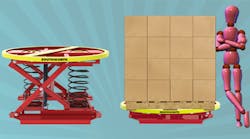Simplify Manual Pallet Loading with Automatic Height Adjustment
Jim Galante, chairman of the EASE council, has been a sturdy link in the supply chain industry for 47 years. When material handling is your business, you’re bound to pick up some stories along the way, and Galante, also the director of Business Development at Southworth Products, has plenty. Listening to him talk, you can imagine the hundreds of times crews gathered ’round in the break room to hear Galante’s folksy-yet-firm take on the industry. He’ll talk your ear off about pallet use in grocery stores, and you’ll actually want to hear more.
Galante literally wrote the book on ergonomics. Well, technically “Ergonomic Guidelines for Manual Material Handling” is more of a booklet, and he actually was lead editor, but you get the point. The guy knows his stuff. That makes the new story he tells all the more disturbing.
“We are faced today with a very rapidly aging and obese workforce,” he says. “A third of the population is overweight. The average age of a material handling worker is 56, where 20 years ago it was 28. We’ve got this workforce that has changed, and now we’re asking them to do physical work which they don’t have the physical stamina or ability to do.”
The work is not subsiding, though. It’s increasing exponentially.
Galante, who often speaks at national material handling and ergonomics conferences, cites the estimated 1.9 billion pallets in America’s industrial pipeline, and how a “vast majority of those have to be loaded and unloaded by hand.”
In a grocery store, the products on a pallet may have to be handled three times or more, and a busy supermarket may receive 27 pallets a night.
This leads to a lot of movements that can put great strain on a body: bending over, reaching down, picking up.
That might not be as difficult when grabbing boxes at chest level, but after a few strenuous hours, those last few cases of gaskets a few inches off the ground may feel like a basket of bowling balls when lifting them up.
Aside from buying a fleet of material handling robots or injecting workers with HGH, what can be done?
This question reminds Galante of a doctor at an industrial medical clinic in the early 1980s who kept treating patients with lower back issues. Galante says the doctor then walked the plant floor to find the cause.
“Being a doctor, it didn’t take but three seconds to realize what the problem was,” Galante says. It was, of course, the physical tasks asked of any manual material handler dealing with pallets.
The doctor knew the solution was to elevate the pallets and reduce stress on the spine, and although not a formally trained engineer, had a design in mind. It’s an oft-overlooked invention you may see every day, if you’re around a cafeteria: a spring-loaded plate dispenser.
By 1985 the doctor had connected with Southworth, which at the time was making a big push toward increasing productivity through the science of ergonomics. The result was the first PalletPal Level Loader, which uses calibrated springs and scissor mechanisms to keep material at a comfortable working height.
Although the general physics behind, or rather within, the loader have not changed much, Galante can remember how every little tweak has made the product so effective.
“As we refined the task, learned more about the business of pallet loading and unloading, we refined the product to do the task faster safer and easier.”
A turntable was added to form the PalletPal 360, which allows the pallet to spin. Southworth found this has one of the biggest impacts on time efficiency.
“We discovered in tests that 40% loading or unloading is spent walking around it,” Galante says. “The turntable became a very important, utilitarian component to the refinements.”
By allowing it to spin, you no longer have to walk around the pallet, but simply turn the boxes toward you. This also reduces the potential for tripping over the pallet, which could lead to the loss of time due to injury.
The key to the PalletPal, though, is the spring.
“There’s a lot of science behind the spring calibration,” Galante says, though it’s not “rocket science." He does say the success of a spring that doesn’t lose its calibration and can lift up to 4,500 lb took more experience than math. “The development of the spring and how it’s positioned is a leaned art.”
The springs don’t rust or corrode, either, and Southworth offers a lifetime guarantee on the PalletPal, which requires little to no maintenance. There are 25-year-old PalletPals still going strong, the company says.Back then, obesity was only at 12%, and many workers were in their prime. Along with having amazing softball teams, the companies didn’t have to worry about the problems of today’s workforce. And the productivity issue is important, but another costly issue could come from injury, which inspired the Pallet Pal to be invented. And will most likely keep Southworth in business for the foreseeable future.
Galante often mentions workman compensation statistics in his speeches, and a few are downright frightening: 60% of all claims come from material handling issues, and about the same number is due to back injuries. This becomes extremely costly, says Galante.
“Carpal tunnel? That’s nothing. That’s a walk in the park. $6,000 to correct it. The average back surgery is $90,000.”











